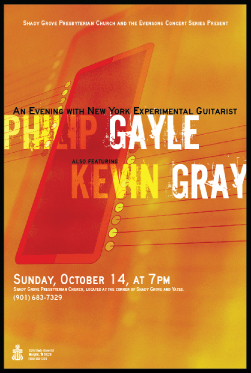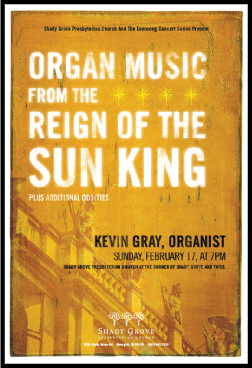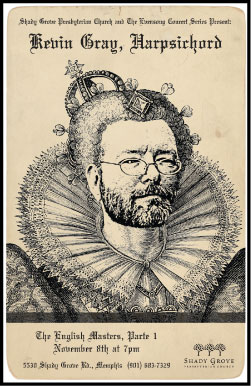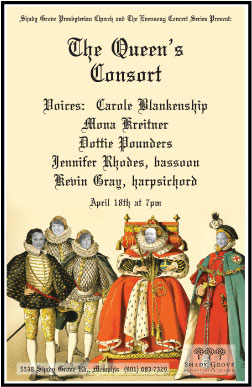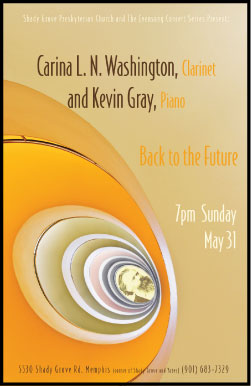
The following is the transcript of an interview of Kevin H. Gray by Michelle Vigneau in August, 2010. Michelle Vigneau, DMA, is Associate Professor of Oboe, Assistant Director of Graduate Admissions and Assistantships, and Director of Undergraduate Music Theory at the University of Memphis. She is also a member of PRIZM ensemble, Memphis Woodwind Quintet, and the Eroica Ensemble. Dr. Vigneau played the premiere performances of both Entropic Varia, and Beatcore: Dance-scene for Dziga Vertov.
Dr. Vigneau: Which people and ideas do you feel have influenced you most as a composer?
Mr. Gray: Certainly, it’s not only possible, but commonplace, for composers to be influenced by ideas encountered through contact with other disciplines, such as painting, poetry, architecture, or whatever the source of the inspiration may be. For example, I am keenly interested in painting, (and even paint, myself) and often am aware that a visible structural element, perhaps something in a painting that I‘m drawn to, has metamorphosed, unbidden, into an auditory structure of pitches, timbres, and rhythms, in my head. This was partly how my set of bassoon pieces, The Spattered Hand, came into being.
This propensity that ideas have for interdisciplinary migration, is one of several reasons that I feel driven to paint, even though some would say that it takes time away from my composing.
I do think, though, that most composers probably feel the influence of other composers the most strongly; I know I do. The composers from the last half-century or so that I most admire, and from whom I feel I’ve learned the most, are Nancarrow, Messiaen, Carter, Boulez, Xenakis, and Fukushima. Without the benefit of several more decades of hindsight, these individuals seem, to me, to be the real musical giants of the second half of the twentieth century, at least in the realm of avant-garde composed music. I’ve learned a great deal from each of them, through study of their music.
Dr. Vigneau: Could you elaborate a bit about what you feel you’ve learned from each of these composers?
Mr. Gray: Nancarrow and Messiaen have exerted a huge influence on my approach to rhythm as a means of creating unity within a composition. I admire Carter and Boulez especially for their innovations in form and structure, though each is quite different from the other. Xenakis, I think, teaches us that no successful composition can arise without a unique and meaningful generating concept. Fukushima, despite his importance to me, is the afore-mentioned composer about whom I know the least. My acquaintance with him is limited to his compositions for flute and/or piano, but I see in these works something remarkable in their seeming ability to project a palpably spiritual element that I find I miss whenever I listen to someone else’s music after listening to his.
Dr. Vigneau: I find it odd, given your high regard for Fukushima, that you haven’t made a point of learning more about him.
Mr. Gray: Well, I look at it this way: I have, for so many years now, held his music in such consistently high esteem, and so admired him as the creator of something that I feel to be truly inspired, that I’m almost afraid to know more about him. After all, excessive familiarity sometimes leads to tarnished idols. Besides, given that his music has touched me so deeply, I think my knowledge of him is complete. From one thing, know a thousand things.
Dr. Vigneau: That’s a Zen proverb.
Mr. Gray: Yes.
Dr. Vigneau: Which composers before 1950 do you find most appealing, or instructive?
Mr. Gray: Machaut, Gesualdo, Bachs, J. S. and C. P. E., Scarlatti, Brahms, Stravinsky, Ives, and Webern. Also, the late medieval scene in Paris as documented in the Chantilly Codex, and elsewhere, is a perpetual fascination, as is the French Baroque, which was populated by so many geniuses, such as the Couperins, the Forquerays, Rameau, Roberday, Nivers, Chambonnieres, Chaumont, Geoffroy… almost too many to mention, and more than any one person could absorb in two lifetimes. I also have a similar, and more recent, obsession with English music before 1700, particularly with Dunstable, Powers, Blitheman, Tallis, Redford, and Purcell. I hope one day to record a hefty portion of the Mulliner Book on harpsichord and organ.
Dr. Vigneau: I’m aware that your musical tastes are far-reaching, so it’s natural to assume that you have important musical influences other than composers from the tradition of Eurocentric academia. Could you tell us about some of them?
Mr. Gray: I think that one of the most significant musical trends since 1960 is the increased blurring of stylistic boundaries between the traditions of Eurocentric academia and other music. I was brought up to believe that “classical” music, or in other words, music written by (mostly) dead (mostly) European (mostly) white (mostly) males who either were named Bach and Beethoven or who revered Bach and Beethoven, was intrinsically superior to all other music, like “popular” music, “ethnic” music, or jazz. For an embarrassingly large number of years, this pseudo-intellectual snobbery literally held me hostage, preventing serious investigation outside the tradition.
Gradually, though, a degree of maturity coupled with outside influences effectively broadened my horizons, and dispelled many of my biases. My paternal grandmother (who, though not a musician, was very much a free thinker) defied my parents’ traditionalism and disdain for dissonance by exposing me to Stravinsky, Prokofiev, and Shostakovich at an early age. Schoolmates exposed me to rock music, much to the chagrin of my fundamentalist parents. Good old-fashioned teenage rebellion led me to Ravi Shankar and Indian music via the Beatles. I discovered other indigenous music of Asia later, through Lou Harrison and Harry Partch. I had my dad, early on, to thank for exposing me to the great jazz of the thirties and forties, and later on, friends and natural curiosity helped advance my jazz education.
So, yes, I am aware of being influenced by a number of musical obsessions other than the composers I mentioned earlier. I have a huge number of recordings by oud players, and I am fascinated by the music of the Arab world. I continue to be astonished by the breadth and scope of Asian music. The San-Jo music of Korea, the structured improvisations of Indian sitarists, and the emotional depth of Uzbek music, just to name a few examples, will probably always fascinate. I have spent many happy hours absorbing the ritualistic music of Cameroon’s Bibayek tribe. And, of course, jazz and modern improvised music by the likes of Derek Bailey, Borah Bergman, Wilbert de Joode, Frank Gratkowsky, Philip Gayle, and the Tone Road Ramblers, have been hugely rewarding.
And, last, but definitely not least, like many my age, rock music has been a central obsession of mine since I was twelve or so. I can honestly say that I often get the same thrill, now, from listening to U. S. Maple or Sonic Youth, that I did when I was fifteen or sixteen listening to King Crimson, Jethro Tull, or Zeppelin. My composition, Beatcore: Dance-scene for Dziga Vertov, wears its rock influence on its sleeve, but I’m sure that my music is full of less obvious moments and traits that bear the influence of rock that I’m not even aware of.
I do think it’s important to note, however, that not all of these things influence me to the same degree, nor in the same way. While I feel that a great deal of imagination might not be required in order for a skilled observer to point to specific ways in which the influence of, say, Messiaen, might be noticeable in some particular passage in my music that utilizes palindromic rhythms, the influence of Korean San-Jo music on my approach to counterpoint or the influence of a Turkish oud player’s unusual melodic inflection might be more difficult for anyone else to pinpoint. But I know that they are there.
Dr. Vigneau: Which jazz musicians do you most closely identify with, and in what ways does jazz influence you?
Mr. Gray: For me, the jazz universe revolves around the brilliant clarinetist and improviser, Jimmy Giuffre. I feel that the trio in which he performed and recorded with Paul Bley and Steve Swallow in the early sixties produced some of the most sophisticated and beautiful music ever. I have even arranged some of these trio pieces for piano solo and performed them. (Some of them are on YouTube.) I also especially admire Duke Ellington, Fats Waller, Ornette, Coltrane, Bud Powell, Walt Dickerson, Teddy Charles, Cecil Taylor, and, of course, Art Tatum. The influence of jazz in my composing? There are moments in my writing, such as the second movement of the first flute sonata, in which the rhythm intentionally evokes the spirit of jazz, but on a deeper level I feel that the period (the nineties) during which I primarily focused on developing as an improviser, has helped me as a composer by causing me to seek the quality of immediacy in my writing more than I might have otherwise.
Dr. Vigneau: I know you were active, if not prolific, as a composer from the late seventies through about 1990, when you produced a number of mostly shorter works that belong to the avant-garde tradition, but then you seem not to have written any new music until about 2004. Could you comment on that?
Mr. Gray: Well, that isn’t entirely true. While I was intermittently active as a composer from the late seventies throughout the eighties (a period when composing took a definite backseat to developing as a pianist) I didn’t entirely stop composing between 1990 and 2004. During that period, though, particularly from 1990 until about 1998, I was mostly interested in jazz, and other, more extreme flavors of improvised music, and so my output during those years is almost entirely limited to solo piano pieces in a jazz vein. Having performed most of them quite a bit when they were new, I’m essentially bored with them now. However, there was another reason, beyond a shift of interests, why my composing might be seen as having fallen by the wayside. Everything I wrote up until 1990 was done the old-fashioned way: by hand. The older I got, the more uncomfortable that became for me.
Dr. Vigneau: Are you talking about writer’s cramp?
Mr. Gray: Well, yes. Perhaps because I’ve played piano since age six, and now, of course, I have mild arthritis, but I’ve always been very prone to writer’s cramp. Even as a teenager it was painful for me whenever I used a pen or pencil for longer than an hour or so. I can recall having to take aspirin after long evenings of homework, when I was in high school. But by 1990 the pain became much more intense and persistent, and could be brought on by as little as five or ten minutes of pencil use. So, I made the decision, reluctantly, to set aside composition in order to better preserve whatever years of service might still be in my hands, for the sake of my love of performing. Then, in 2004, I decided (finally!) to try notation software. I’m a devoted Sibelius user. Since typing has never unduly stressed my hands, I’m back in business, so to speak.
Dr. Vigneau: So, do you have a large backlog of pieces still in manuscript that you plan to convert and then gradually issue?
Mr. Gray: Some of my older pieces are worth saving, and others are not. I evaluate my catalogue fairly critically, and will only issue the pieces that I consider to be deserving. For example, I wrote a piano sonata when I was still a teenager, sixteen or so, I believe, that embraced the harmonic freedom of the twentieth century, but ignored the century’s rhythmic innovations. Imagine Schumann with two-thirds of the notes wrong. It was quite wretched, and I destroyed it years ago. A similar fate has befallen many of the things I wrote up through 1990. I may not literally have destroyed them, but neither will I ever publish them. On the other hand, some of the better pieces may gradually be made available, though the production of new music is the priority. But in any event, I would describe it as a small backlog rather than a large one. I don’t consider myself extremely prolific; I feel that I compose rather slowly, and that was even more the case when I did everything by hand.
I will say that any of my pre-1990 works that ever see the light of day will have inevitably undergone recent revision before I will be comfortable releasing them. I know that I am a better composer now than I was then, and I’ll want these older pieces to have the benefit of at least some of what I’ve learned in the intervening years.
Dr. Vigneau: I find it a bit difficult to reconcile your perspective that you compose slowly, and aren’t particularly prolific, with the sheer size of your catalogue of compositions.
Mr. Gray: I do feel that I work slowly, compared with a number of other composers with whose habits I have a cursory familiarity, but I am truly fortunate in having large amounts of time to devote to composition.
Dr. Vigneau: During the eighties you were a composition student of John Baur. Tell us a little about that.
Mr. Gray: We had a great relationship, and I doubt he realizes just how much I valued his instruction. He taught me to question everything, challenged my thinking about structure, and also taught me to value the role of periodicity in composition. With me, he had his work cut out for him: in 1980, with the righteous tendentiousness that only youth may properly effect, I would have referred to any composer who used the same time signature in two successive measures as intellectually lazy.
Dr. Vigneau: Now, of course, some of your pieces have but a single time signature throughout.
Mr. Gray: Wait, you promised not to tell anyone that…
Dr. Vigneau: Why have you never embraced alternative notation schemes, such as proportional notation, given your fondness for unusual, and often improvisatory-sounding rhythms?
Mr. Gray: Well, I feel that proportional notation allows me too little control over rhythmic minutiae for me to be comfortable with it. Plus, I enjoy the tyranny, simplicity, and, ultimately, the challenge, freedom and flexibility of the system of notation that we have commonly inherited. One of the many processes that are inherent to the way I compose, that I particularly relish, is the process of discovering the most effective way to notate complex structures. Measures, barlines, and time signatures are always meaningful in my scores, just not always in the traditional fashion. The more complex my music looks on the page, the more you may be sure I have thoroughly experimented with sometimes numerous alternatives before settling upon the version reflected in the completed score. I am an inveterate tinkerer, I’m afraid.
Dr. Vigneau: I’d love to hear you comment on why you’re so drawn to compose for woodwinds, and especially the bassoon, and further, why chamber music seems to dominate your output.
Mr. Gray: It’s true; the instruments that I feel the most empathy for are all either woodwinds, or keyboards. If you look at a listing of my compositions, this is immediately obvious. The fact of having enjoyed a long career as a collaborative pianist, I think, is at least partially, if not largely, responsible for my preference for writing duos, trios, quartets, and, rarely, quintets. I am never quite happy with music for more than five players, whether judged from the perspective of composer, performer, or listener. For me, there just seems to be a logistical boundary of sorts that prevents music for six or more from achieving the last word in precision of ensemble. I’m sure there are many who disagree. But this concern for tight ensemble playing, I imagine, is also partly to blame for my love for wind players’ natural ability to deliver truly incisive entrances, that can rival keyboard instruments in that regard.
Really, on a very basic level, my affinity for winds probably all comes down to the fact of wind instruments sounding more like keyboard instruments than strings do. I’m really not a fan of extreme or omnipresent vibrato, and many string players (not to mention singers) habitually utilize a good bit more vibrato than I can pleasurably endure. I don’t generally feel that highly chromatic music is well-served by excessive vibrato. Among wind players, however, my observation has been that only flutists and saxophonists have slight statistical likelihood of developing what I jokingly refer to as vibrato abuse syndrome.
As far as the bassoon goes, it is certainly true that the instrument has figured quite prominently in my output since 2005. I think we can credit this equally to two things. First, there is my objective admiration for the instrument itself, its fine palette of timbres, its expressive range, and its agility. There is also the fact that, led by Lecolion Washington, bassoonists have really been the first group of instrumentalists to embrace my compositions to a significant degree. When a player of such caliber as Lecolion is eager to play your music, it’s only natural for you to want to produce more of it. Lecolion has now mounted several single-composer concerts of my music, which, from my perspective, is a fairly Herculean feat, given the difficulty of much of my music. He gave three such concerts in 2010, including one for the International Double Reed Society’s convention. Lecolion’s selfless belief in my abilities as a composer led him to promote my work to other bassoonists, notably his former teacher, Kristin Wolfe Jensen, who then commissioned my piece for two bassoons and piano, Papageno’s Dreams. She and Lecolion have performed that piece together a few times now at various places, and have recorded it, as well.
Having said what I said a few moments ago about stringed instruments, I would like to add that a handful of my pre-1990 compositions do, in fact, involve string instruments. During the mid-eighties I composed a very brief string trio, for violin, viola, and cello, a three-movement trio for alto saxophone, cello, and harpsichord, and a sextet whose instrumentation combined violin and cello (albeit entirely pizzicato) with harp, guitar, harpsichord, and marimba.
While many who know me know that I don’t particularly relish the sound of massed strings, it is nonetheless likely that chamber music involving strings is lurking somewhere in my future.
Dr. Vigneau: You’ve also made substantial contributions to flute literature. Would you tell us a little about these pieces, and comment on why you feel especially drawn to write for the flute?
Mr. Gray: I’ve written, in addition to a handful of shorter things that involve flute, two sonatas for flute and piano, both composed between 2005 and 2007. The first sonata is the more traditional of the two, consisting of four movements arranged in a fast-fast-slow-fast sequence. It’s about eighteen minutes long and is dedicated to Laura Ezera, a remarkable flutist from Latvia with whom I was fortunate enough to perform and record. The second sonata began as a sort of clearing house for ideas that didn’t fit into the first sonata, but quickly assumed a life and purpose of its own. It is more unconventional, and consists of two movements in the same tempo, the second of which is roughly twice the duration of the first. Presently, neither sonata has been performed.
Regarding my predilection for the flute, I think it arises from my respect for the instrument’s great nimbleness, its terrific range of tone colors and articulation, and its natural expressiveness. Flute and bassoon, both, for me, possess a primal, earthy sonority of which I never tire. This makes both of them, to me, among other things, a perfect counterpoint to the sonority of the piano. Flute literature has been one of my areas of focus as a collaborative pianist, and I have been fortunate enough to perform with many gifted players.
Dr. Vigneau: The second flute sonata bears an inscription, a quotation from a nineteenth century Japanese poet. What is the significance of that?
Mr. Gray: I’ll paraphrase the quote. “The emperor doesn’t do any actual fighting, but orders the people to spill each others’ blood.” It’s from a poem by Yosano Akiko. Although she is appreciated for the frankly erotic nature of much of her verse, this particular poem has a strongly anti-war theme. So the second sonata is intended as a protest against the horror and absurdity of America’s ongoing war, much as Prokofiev did in his sixth piano sonata, or Shostakovich did in his eighth string quartet. The tradition of music (even instrumental music) as a vehicle for political protest is very rich, with important contributions from composers as stylistically and chronologically diverse as Clement Janequin and Frank Zappa.
Dr. Vigneau: The wind instrument which appears most frequently in your compositions, after the bassoon, is the clarinet. You’ve written a dozen or so pieces for either B-flat clarinet, clarinet in A, or bass clarinet. One of these pieces, Pyrrhic Suite, for clarinet in A and piano, was the winner of the International Clarinet Association’s 2010 Composition Competition. Tell us something about this piece, and also about some of your other clarinet works.
Mr. Gray: Pyrrhic Suite is inspired by historic accounts of the tradition of military training dances, as practiced in ancient Greece. I think most people have trouble, nowadays, wrapping their heads around the image of soldiers-in-training all dancing together, because we certainly can’t imagine modern boot camp including dance class. But, nonetheless, this was very much the case in the time of Plato. So, the suite imagines anew these military training dances, and purports to explore the emotions for which these dances may have given safe outlet. There are five movements, a number of extended techniques, frequently daunting rhythmic structure, and challenging ensemble. The clarinetist Richard Faria and pianist Josh Oxford, both of Ithaca, New York, played the premiere at the International Clarinet Association’s 2010 convention. The piece was very well-received, largely through the tremendous artistry of Rick and Josh, who, as a duo, absolutely played this music to the hilt. I should also mention that the suite was dedicated to Carina L. N. Washington, who was responsible not only for helping me to work out the extended techniques called for in the score, (I’m not a clarinetist!) but also whose persistent belief in my writing was responsible for my entering the competition in the first place. The entire clarinet festival was exciting, as was the double reed convention, and I can’t wait to attend both events again.
Although the Pyrrhic Suite is currently my only large-scale work for clarinet and piano, there are a number of chamber works that include clarinet in various settings. The Requiem for Derek Bailey is a trio which exists in two versions, one for flute, clarinet, and bassoon, and the other for oboe, clarinet, and bassoon. It’s a very challenging work, despite its brevity. There’s also Burnish Cluster, for clarinet and harpsichord, another brief but challenging work of which I am particularly fond. There are also several works for bass clarinet. Among these are pieces that are transcriptions of my bassoon works, as well as works originally conceived for the instrument. There are also several things for various clarinets in development.
I’ve also recently written a wind quintet, Entropic Varia II, with which I’m quite happy, and although I’ve previously written for flute, clarinet, oboe, and bassoon, this was my first time to write for horn, and I was considerably more jazzed about it than I anticipated being. So, a work for horn and piano will likely materialize in the near future, as well as another wind quintet, which is already in the planning stages. I’m also increasingly drawn to the English horn, and am currently engaged in a piece which will be titled Schlieren, which is for English horn, clarinet in A, and piano.
Dr. Vigneau: Among your pieces, which are your favorites, or the ones you feel are most successful, or that reflect your personality most effectively?
Mr. Gray: Even though I never make available a composition with which I am not completely happy, I think it’s only human nature to develop favorites. Chronaxie, for me, is the piece to which I feel perhaps the most personal connection, and that I feel best embodies what I do well as a composer, as well as having been my most slowly gestating piece. It’s a lengthy, single-movement work for oboe, bassoon, and piano whose composition occupied me for five years.
Dr. Vigneau: What philosophies, perspectives, or over-arching goals color or drive your composing?
Mr. Gray: All of the profound innovations and achievements of the most daring creators of the twentieth century actually happened, and cannot be made to have un-happened. The aesthetic and goals of modernism are my aesthetic and goals. Webern dreamt of a day when school children would gleefully sing intricate serial compositions instead of nursery rhymes. While this may seem naïve, the underlying and driving tenet of his conviction, that art must advance rather than retreat, is lingua franca with me.
I have always been drawn to music that is logical without being predictable. This paradigm drives all that I do as a composer. I have always, even as a young child, found dissonance pleasurable. I continue to do so. As an adult, I have developed the conviction that an intricately textured world of pitch most happily resides within a complex rhythmic continuum.
The pervasive idea that modernism and abstraction (not just in music, but throughout the arts) are dead or depleted is absurd. Before the upheavals in the early twentieth century that gave us the music of Ives, Webern, Stravinsky, Bartok, and so many other great men, musicians happily and, often productively, explored the recesses of tertiary tonality for literally hundreds of years, and many continue to do so, still, today. The idea that further discoveries are no longer possible within newer, more fertile, systems of musical organization, that could, arguably, be said to be still in their infancy, is hardly worthy of contention.
Dr. Vigneau: What’s next for you?
Mr. Gray: That’s hard to say. In some ways, I’m very much a shoot-from-the-hip kind of guy. After composing in relative isolation for so many years, the experience of having people I don’t even personally know express interest in my compositions has taken a bit of time to get used to, but has of course been enormously gratifying. I am humbled by and thankful to the talented and committed performers who have chosen to play my stuff from among the myriad other worthy things that are out there, and it is a tremendous thrill for me to travel about and get to work with these folks.
Recordings used by express permission of performers.
All other content: Copyright © 2010, 2012 by Kevin H. Gray.
Unauthorized use or duplication constitutes copyright infringement.


